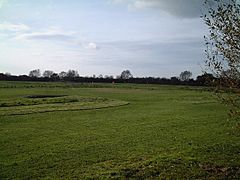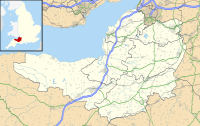Locking Castle facts for kids
Quick facts for kids Locking Castle |
|
|---|---|
| Locking, Somerset, England | |

The site which is now a golf course
|
|
| Coordinates | 51°20′36″N 2°54′53″W / 51.3434°N 2.9147°W |
| Type | Motte and bailey |
Locking Castle was a historic castle that once stood on Carberry Hill. This area is near the former RAF Locking in the village of Locking, which is in the North Somerset district of Somerset, England. Today, the remains of the castle are protected as an ancient monument, meaning they are important historical sites.
Contents
What Was Locking Castle?
Locking Castle was a type of early castle known as a motte and bailey. This design was very popular after the Norman Conquest of England. A "motte" is a large earth mound, usually with a wooden or stone tower on top. The "bailey" is a walled courtyard or enclosure next to the motte, where people lived and worked.
This castle was built on Carberry Hill. While the exact reasons for its construction are not fully clear, it would have been used for defense and to control the surrounding land.
Digging Up the Past: What We Found
In 1902, archaeologists carried out excavations at the site of Locking Castle. During these digs, they found some interesting clues about what the castle was like. They discovered the remains of a small stone room, which was surrounded by a ditch.
Other items found included pieces of pottery, which can tell us about the daily lives of the people who lived there. They also found parts of a sword, suggesting the castle had a military purpose. A coin from the time of King Edward IV was also uncovered. This coin helps historians figure out when the castle was in use or when certain activities took place there.
The Castle's Remains Today
Even though the castle is long gone, you can still see some parts of its original structure. Around the area where the castle stood, there is a long earth bank. This bank is about 60 meters (nearly 200 feet) long and stands about 1.5 meters (about 5 feet) high. There is also a ditch next to it, which would have been part of the castle's defenses.
West of the main courtyard, or "inner bailey," there's an area that might have been a pillow mound. A pillow mound is a raised area of ground that was built to farm rabbits. Rabbits were an important source of food and fur in medieval times.
The Castle's Story: From Defense to Priory Land
The exact beginnings of Locking Castle are a bit of a mystery. Historians believe it might have been part of the larger estates of either Kewstoke or Hutton. These two areas were later joined together.
Around the year 1100, King Henry I gave these combined lands to a person named Geoffrey de Dun. This shows how land and power were often given out by the king in those times.
However, the castle's military importance did not last forever. In 1214, the land at Locking was given to Woodspring Priory. A priory is a type of monastery, a religious community. Once the land belonged to the priory, the castle would no longer have been needed for military defense. It likely fell into disuse and eventually became the ruins we see today.


